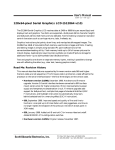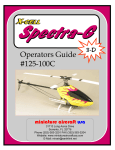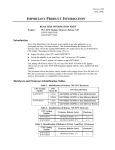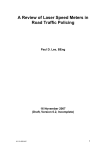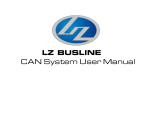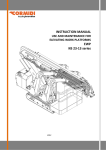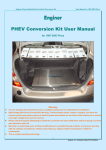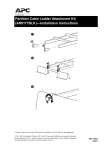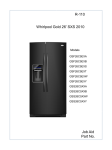Download The must read guide for moped owners
Transcript
Videos for reference
Cleaning a carb: http://www.youtube.com/watch?v=0sMUAFbtAa4
Adjusting carb: http://www.youtube.com/watch?v=CSj1wOMqkKo
What is a Scooter?-Back to TopWell, here's what Wikipedia has to say:
A scooter is a style of two-wheeled motor vehicle traditionally defined by characteristics such as a step-through
frame, wheels less than 16" in diameter, and an engine located below the rider and to the rear.
That pretty much sums it up. Motorcycles have an engine mounted in the middle of the frame with a gas tank above
it. The rider sits astride the engine with the gas tank right in front of them. Motorcycle wheels are also typically larger
(over 16" diameter) than those on a scooter. Another major difference is that the engine of a motorcycle is attached to
the frame, while on a scooter it is usually part of the rear suspension. So when a motorcycle rear wheel goes up and
down, the engine remains stationary, while when the rear wheel of a motor scooter goes up and down, the whole
engine and transmission moves up and down with it.
These days, 99% of scooters have a "twist and go" automatic (CVT) transmission, which means you don't have a
clutch to control and you don't have to change gears, while 99% or motorcycles have a manual clutch and you have
to shift gears manually (with your left foot). This also means that on 99% of motor scooters you apply the rear brake
with your left hand, while on 99% of motorcycles you apply the rear brake with your right foot. While there are still a
few manual scooters and there are a few automatic motorcycles, both are very much the exception rather than the
rule.
These differences result in a motorcycle usually having better acceleration high speed handling characteristics, but a
motor scooter is often more maneuverable at low speed and is easier to ride, especially for novices.
Scooters usually have a small engine, from 50cc to 250cc, though there are 400cc and even 800cc scooters, so
engine size doesn't define them. While most are limited in speed, scooters with a larger engine can exceed 100mph
and cruise easily at freeway speeds, so speed isn't a defining characteristic either.
So what is a moped then? That's a little trickier, but the working definition for most DMVs is a motorized two wheeled
vehicle with an engine of less than 50cc capacity. It used to be that a moped was a Motorized pedal cycle, i.e.
basically a bicycle with a small engine, but some jurisdictions don't require pedals. Again we can also look at
Wikipedia for a definition:
Mopeds are a class of low-powered (under 50cc displacement) motorized vehicle, generally two-wheeled. A Moped is
driven in an upright position with the rider's back perpendicular to the seat . From a practical point of view, in most
jurisdictions mopeds can be ridden without requiring a motorcycle license (a car license is sufficient). They may be
speed limited by design, but even if they aren't, the small engine size usually limits then to a top speed under 40mph
(maybe 45mph downhill with a tail wind). In the United States the definition and regulation of mopeds differs from
state to state. Again calling on Wikipedia:
Legal terms and definitions of low-powered cycles vary from state to state and may or may not include "Moped,"
"Motorcycle," "Motorized Bicycle," "Motorscooter," "Goped," "Motor-Driven Cycle," and or others. A moped's speed
generally may not exceed 30 mph (48 km/h) on level ground, even if it is capable of going faster. In a few states this
number is 20 or 25 mph (32 or 40 km/h), and in most states, the maximum engine capacity is 50 cc. However,
Kansas ("Motorized Bicycle" K.S.A. 8-126, 8-1439a) allows up to 130 cc[13]. Some states, like California, require
pedals, while others do not. Virginia allows mopeds to operate at up to 35 mph (56 km/h). Some states, like North
Carolina, require there to be no external gear-shifting mechanism.
How Much does a Scooter Cost?
Japanese and Italian scooters which are sold through authorized dealers, the price goes up significantly. For a 50cc
scooter expect to pay around $3300 for something like a Vespa LX 50, which is a "classic" small scooter or
something like $3000 for an Aprilia SR50 (fuel injected two-stroke) which is a little more sleek and modern looking.
The classic Honda Metropolitan 50cc sells for around $2000.
Going up to a 250cc, for something like an Aprilia SportCity 250 expect to pay around $4600, or $5400 for a Honda
Helix. If you go to larger scooters like the Honda Siver Wing (580cc) you'll pay $8100 ($8600 with true APS braking).
The 400cc Yamaha Majesty sells for around $6100 and the Suzuki Bergman 650 will cost you $9000.
How fast do Scooters go?
Small 50cc scooters ("Mopeds") are good for about 30 mph, maybe 35 mph in some states without speed restrictions.
They will just about keep up with urban traffic, but you have to ride them WOT (Wide Open Throttle) do to that. This
can be good for novices and young riders because in most of states the rider does not need a motorcycle license to
operate a 50cc less scooter, but the inability to keep up with faster traffic can sometimes be a hazard as cars try to
"squeeze" past you when there really isn't room.
150cc Chinese scooter. It might look fast, but it's not really very happy above 60 mph. Mid sized 150cc scooters are
good for 55-65 mph, though with a long enough run at it they may get up to 65+mph, especially if there's a tail wind or
slight downhill grade. 45-50mph is enough to keep up with most urban and suburban traffic, though it's really not
enough to flow with the traffic on a freeway, where speeds of 65-75mph are more normal. We¡¯d certainly
recommend a 150cc scooter over a 50cc scooter for commuting unless you live in Manhattan. Most of the 150cc
scooters cruise quite comfortably at 45-50mph.
If you want a high speed machine, you would probably be better off with a motorcycle.? 250cc scooters are just about
OK for freeway use and should be able to cruise at 60mph and get up to speeds of 70mph or more if pushed. We
wouldn't recommend riding anything less than a 250cc scooter on the freeway, you might want to check on our 300cc
motorcycle that is listed on our website.
What MPG Does a Scooter Get?-Back to TopThis depends mostly on the engine size. The smallest engines are typically 49cc and they can give up to 90 mpg,
depending on what type of riding you do and how much you weigh. Obviously if you weight 300lbs and do mostly
short "stop and go" trips you'll get a lower mileage than if you weight 100lbs and travel mostly on long trips at modest
speeds. At the extreme, we've seen figures of 110-120 mpg for 50c scooters when the rider was trying their best to
drive as economically as possible.
150cc scooters aren't quite as frugal, but we've seen reports of up to 85mpg. With the larger engine sizes (300cc) you
should still get around 70 mpg from a scooter traveling at legal highway speeds. That's about the same as a Toyota
Prius Hybrid, but the scooter will be a lot more fun!
Scooter Wheel & Tire Size -Back to TopMotor Scooter wheel size varies from a minimum of about 10" to a maximum of around 16". Most are either 12" or
13". This is the size of the metal wheel itself and doesn't include the tire. The measurements is the diameter of the
wheel rims The tire may add 5" or 6" to the diameter. My scooter has 13" wheels (rims), but the tire measures about
19" across in total.
So what are the advantages and disadvantages of different sized wheels?
Well, the smaller the wheel the more maneuverable the scooter can be. The smaller wheel has less of a gyroscopic
effect making it somewhat easier to turn (though this also depends a lot on steering geometry). So in general,
scooters are more maneuverable than motorcycles (which have larger wheels). The converse of this is that larger
wheels may give better stability at speed.
The downside of smaller wheels is that they don't roll over obstructions in the road as well. Just think of a pothole in
the road. If it's a large hole and a small wheel, the wheel could fall into it! Even if it's a raised obstruction like a tree
branch or a curb, a larger wheel will roll over it with less effort than a small wheel. That's one reason why off-road
trucks often have monster wheels. When you're driving over rocks a big wheel makes life easier. Similarly, if you're
riding over roads filled with potholes (for example New York City!), you'll value larger wheels.
While a few scooters have 16" wheels (e.g. MC_X1507) and a few have 10" wheels (e.g. MC-U1504), most scooters
have a 12" or 13" wheel which is a reasonable compromise between maneuverability and stability.
Scooter tires come in all sizes of course, with a typical 13" wheel scooter tire having a designation something like
"130/60-13". The "13" refers to the wheel rim diameter. The "130/60" part indicates that the width of the tread is
130mm (5.1") and that the tire has an aspect ratio of 0.60 (or 60%), which means that the sidewall height is 60% of
the width of the tire. Some tires are designed for front wheel use, some for rear wheel use and some can be used on
either wheel. Though most tires today are tubeless, there may still be a few tires which require an inner tube,
especially on older scooters.
The tread pattern may be directional, meaning that it has to be mounted the correct way around to perform properly
and there should be an arrow on the sidewall which shows which way the tire should rotate. You may also see a
speed designation on some tires between the "130/60" and "13". This is a letter which runs from "J" to "Y". "J"
indicates the tire is safe to use up to 62mph, "L" is up to 75mph, "N" is up to 87mph, "P" is up to 93mph and "S" is up
to 103mph. You probably won't be going any faster than that on a scooter. However there is a "W" designation shows
the tire is safe up to 168mph. As far as I know there are no "W" rated scooter tires! Most scooter tires will be priced in
the $55-$85 region.
Scooter Repair-Back to TopSo you buy a scooter and something breaks. Who is going to fix it? Well, if you've bough in person from our retail
store in California,? we have access to parts, shop manuals and we will have mechanics trained to fix your scooter.
All you have to do is bring them in.
But what if you are located outside of California, we have a few suggestions for you. You can try contacting local
motorcycle (or better still, scooter) repair shops. If they are not very enthusiastic about working on a Chinese scooter,
no worry! Have them contact our tech support department directly. We will make sure they will have the easy access
to our spare parts and the technical support they need. Remember, we are the only company who actually carries all
common parts in stock.
150cc engine and transmission as used in many Chinese scooters
You might also get some help from a lawn mower repair shop. They are used to working on small engines and the
engine in a scooter isn't all that different from the engine in a lawn mower. You can also try snowmobile and ATV
repair shops.
CVT (transmission) belt. Price ~ $40. Belt life anywhere from 2500 to 10,000 miles
It's not a bad idea to keep a few spares (such as a spare spark plug and CVT belt) on hand, just in case you need
them (and eventually, you will). It's a good idea to remove the CVT cover on your new scooter and read the number
on the belt BEFORE you need to change it. Belt sizes vary, even on the same nominal scooter "model" and by the
time it fails, the size markings may have worn off! The belt size is usually three numbers such as "835-20-30". This
would mean the belt is 835mm long, 20mm wide and has a cross section with a 30¡ã bevel angle.
The best way to avoid needing repairs is regular maintenance, which means changing the oil regularly, changing the
fuel filter and spark plug at the proper intervals, checking the CVT belt and air filter, checking the tires and going
around the scooter at least once a month and making sure that all the bolts are tight (especially the bolts holding the
muffler on). Use the recommended grade of gas (usually higher than 90 octane for most Chinese scooters) and add
fuel stabilizer if the scooter isn't going to be driven for a while.
Though you won't find individual repair manuals for every different Chinese scooter, they are all pretty similar and
many use the same engines and transmission parts.. There are a couple of books which may help. The Haynes guide
is probably the best general reference for the repair of "generic" (i.e. Chinese) scooters. The "Complete Idiot's Guide
to Motor Scooters" is pretty basic and really doesn't give much detailed information, though it's not a bad introduction
to scooters if you really know nothing at all about them.
Troubleshooting -Back to TopMy Scooter Won¡¯t Start-Back to TopTo start a scooter needs three things:
Gas
A spark
Cylinder compression
If your scooter won't start it due to one of the above not being present. Before you start troubleshooting, make sure
there is gas in the tank by actually looking into it. Don't just trust the gas gauge!
Most scooters have four things that need to be done before they can be started with the electric starter:
The ignition has to be turned on
The kill switch (usually near the right grip) has to be in the "on" position
The rear (left) brake lever has to be squeezed.
The starter button must be pressed.
Some scooters may have other interlocks on the front brake or the center stand. Check your owner's manual to make
sure that you are doing all you need to?? complete the electrical circuit which enables it to start.
If the scooter doesn't turn over when you've done all the required operations, there's an electrical problem with the
battery. Make sure the battery is charged. If it is, make sure the fuse hasn't blown. If it hasn't, check to see if you are
getting voltage to the starter motor terminals. If you are, the starter motor is likely defective. Many scooters have a
kick start (see your manual). If the battery is OK and the starter motor doesn't work, try kick starting it. It's usually not
too hard. My scooter usually starts OK on the 2nd or 3rd kick.
If the scooter does turn over but still doesn't start you have to check for a spark and make sure gas is getting to the
engine. To check for a spark, remove the spark plug from the cylinder, hold the tip of the plug against the cylinder
head and crank the engine. You should see a spark across the gap. If you don't, there's a problem with the ignition.
Could be a faulty coil or electronic ignition module which will have to be replaced, or it could just be a lose wire.
If you do have a spark, you need to check the gas. Make sure there is gas in the tank first! If there is you need to
check the fuel valve. Most scooters use a gravity fuel feed by locating the fuel tank higher than the carburetor. The
fuel usually then flows through filter and then through a vacuum operated valve. The valve has three hoses
connected to it. One if from the fuel tank and is for the gas going in, one is connected to the carburetor and is for the
gas coming out and one goes to the engine manifold which provides a vacuum. If you disconnect the hose from the
carburetor, fuel should run out when you crank the engine (be careful to catch the gas if you do this and don't do it
with a hot engine). If you don't see gas the fuel valve may be faulty. You can try applying a vacuum to the control port
of the valve and see if the fuel flows. Sucking on the line is one way to do this (but make sure it's the vacuum line, not
the gas line if you try this!).
If you are getting a spark and you are getting gas to the carburetor and
the engine is turning over on the starter OK, it's possible that the
electrically operated automatic choke has failed. It's supposed to
operate when the engine is cold, but if it's stuck or burned out, the
mixture will be weak and the scooter probably won't start. The automatic
choke is usually a black cylindrical object attached to the carburetor with
a couple of wires coming out of it as shown on the left. It's the only
electrical powered component attached to the carburetor, so it's usually
not hard to spot. If you have a voltmeter you can measure the resistance
across the leads of the choke. It should be somewhere in the region of
around 10 or 20 ohms. If it's an open circuit, it's burned out and will need
to be replaced. If it seems to be OK it may be stuck, or the wiring to it may have a problem. Check to see that it's
getting voltage.
It's also possible that there is a problem with the carburetor and if so you may need to remove it and clean it out. If
the scooter has been sitting for a few months with gas in the carburetor, the gas may have evaporated and left a
sticky "gum" behind that will prevent the carburetor from working properly and which must be removed.
If the automatic choke is OK, the starter cranks the engine, there's gas and there's a spark then there may be an
engine problem. You need to check the cylinder compression. You need a compression tester to do this. It screws in
instead of the spark plug and measures cylinder pressure. When you crank the engine you should see a reading of
around 150 psi or more. If it's 100 psi or less there's likely and engine problem (bad valve, bad piston, failed piston
rings) which will need the engine taken apart to find.
Probably the most common problems are a dead battery or carburetor problems due to bad adjustment or build up of
gummy deposits. Carburetor problems usually come on slowly though. If a scooter is OK one day and refuses to start
the next day, I'd first suspect an electrical problem.
My Scooter is Not Charging -Back to Top-
Make sure the fuse in scooter is good.
Check the wires behind the fuse holder and the charging jack. Sometimes they come loose.
My Scooter is Hard to Start? -Back to Top-
Is the spark plug dirty? Clean or replace it if its dirty
Make sure the carburetor and the intake manifold are tightly secured to the engine.
Check the gasket between the carburetor and intake manifold. Sometimes the gasket is bad and caused
leak. Solution: replace new gasket or just toss the bad gasket away and screw carburetor back. Try to start
again.
?My Scooter Bogs out When I Turn the Throttle ?-Back to Top-
Adjust the screw with the spring on the side of the carburetor. Clockwise to reduce gas flow and
counterclockwise to allow more gas follow. Usually bogged down is caused too much gas going thru the
carburetor.
Give time for it to warm up.
If that does not solve the problem, you need a new carburetor.
My Scooter is Leaking Oil From the Carburetor & Muffler Areas -Back to Top-
Check the gasket between the carburetor and intake manifold. It might be bad or maybe the carburetor
came loose due to engine vibration.
My Electric Start Won¡¯t Work?-Back to Top-
Make sure the squeeze the left handle brake while pressing the electric button.
When the electric start make clicking noise, it means your battery is weak
Check the fuse.
Is your key switch good?
Is the electric start giving out a burnt smell? You might have a burnt out electric start. Sometimes there is no
smell.
My Engine Froze -Back to Top-
The cause is lack of oil getting to the piston and needle bearing areas. Certain oil can¡¯t cling on when the
engine get too hot. As a result, the needle bearing fell apart inside and caused the engine to cease. You can
buy a new a engine or try to rebuild it.? Be sure to always maintain proper engine oil levels to help prevent
this from happening.
How Do I Adjust My Brakes? ?-Back to Top-
Brakes can be tightened by the handbrake area by the handlebar or by the wheel area.
My Scooter is Not Holding Its Charge? -Back to Top-
Using the headlight, electric start and alarm (if applicable) too much will drain the battery.
Gas scooter does have the ability to charge itself but slowly. An optional charger can be for $25 at any local
automotive stores.
Most new scooters would have a full charge and it would be display on the battery gauge. But in time, the
batteries would loose their ability to hold a full charge. That's normal!
Sometimes charging the batteries too much even when they are not low. Most of these batteries charging
cycle are around 250-300 times.
Sometimes store your scooter away for a long period would cause that as well. If the battery power drops
beyond a certain point, the charger would not recognize it. Sometimes you could jump start the batteries by
using a higher Amp charger.
My Scooter Has Problem When Running at High Speed-Back to Top-
If the scooter idles well and runs fine at low speed, but has problems at high speed, the problem may lie
inside the carburetor with the main jet. The fuel/air ratio at higher speeds is set by the jets inside the
carburetor and to get at them the carburetor has to be removed and disassembled. This can be a tricky job
as the parts are small and delicate. The good news is that these carburetors are quite cheap. You can get a
new one for $60-$80, so if you can't make your scooter run smoothly and you don't like the idea of taking the
carburetor apart, you can always replace it!
Scooter Maintenance -Back to TopScooter maintenance is pretty important. It's even more important than on a car because the engine has to work
harder and component failure can more easily lead to loss of control.
Perhaps the most important and easiest item of maintenance is to regularly check the oil level and change the oil at
frequent intervals. We suggest changing the oil at least every 1000 miles is a good idea. The oil capacity is less than
1 liter and so an oil change costs about $3 and takes about 5 minutes. It's cheap insurance to keep your engine
running for as long as possible. Most of the manual recommends changing the transmission oil every 2000 miles or 6
months. Since it only takes about 100ml of oil (which costs under $1) and takes a couple of minutes to do, don't
skimp on transmission oil changes. We recommend using Castrol 10-30W engine oil and Castrol 80/90 transmission
gear oil. Which oil you use is less important than how often you change it, though you probably should avoid using
pure synthetic oil in a scooter, especially during the break in period. Once you have several thousand miles on the
engine, a synthetic blend may be OK, but you should still change the oil regularly.
Checking tire pressure regularly is also very important. Unlike a car, a scooter only has two wheels and tire problems
can lead more easily to a loss of control and possible injury, so making sure your tire pressures are correct makes
sense.
Though a standard maintenance schedule calls for checking bolt tightness every 1000 miles or 6 months, it certainly
doesn't hurt to do it more frequently.
Every 250 miles or every month:
Check engine oil level
Check tire pressure
Check lights and horn
Check battery level
Every 1000 miles or every 6 months
Change engine oil
Check tires for wear
Check valve stems for splits or cracks
Check brakes and throttle operation. Lubricate cables if required
Check all screws nuts and bolts and tighten. Especially check muffler and exhaust fasteners and front and
rear axles
Every 2000 miles or every year
Change the transmission oil
Check and adjust valve clearance
Clean air cleaner
Check and clean (or replace) spark plug
Check brake linings.
Check/clean/lubricate brake and throttle cables.
Check CVT drive belt for wear and cracks
Check wheel and steering bearings
Though not exactly maintenance, We'd recommend carrying a basic tool kit at all times. That would include the
following items:
3/8" drive metric socket set
Flat blade and Phillips head screwdrivers
Roll of electrical tape
Roll of duct tape
Pair of pliers
Pair or wire cutters
Flashlight (LED type for long battery life)
Short length of wire
Set of metric wrenches
Short length of fuel/vacuum hose
Spark plug wrench and spare spark plug
A few nylon cable ties
Scooter Brake-In -Back to TopDifferent manufacturers recommend different break in procedures. For example most of our scooters manufacturers
recommend the following:
0-150km maximum speed 30km/hr?
151-300km maximum speed 40km/hr
301-800km maximum speed 50km/hr
801-1500km maximum speed 60km/hr
Of course the speedometer is calibrated in mph and the odometer reads in miles, so some translation is needed. In
round numbers these instructions correspond to:
0-100 miles maximum speed 20 mph
101-200 miles maximum speed 25 mph
201-500 miles maximum speed 30 mph
501-1000 miles maximum speed 40 mph
What we recommend is to use the "ride it like you'll ride it (but gently)" technique. That involves riding pretty gently for
the first 25 miles (speed under 30 mph, revs under 4000 rpm), then changing the original Chinese engine and
transmission oil. The original oil might be OK or it might be "cheap and nasty". You have no real way of telling, so
change it, then you'll be sure. You may replace the original oils with Castrol GTX 10-30W in the engine and Castrol
Hypoid 80/90 gear oil in the transmission. For the next 175 miles (25-200) you still should take it quite easy with no
rapid acceleration, keeping the speed down below 40mph or 5000 rpm, then go ahead change the engine oil again.
Since there is no real oil filter (the "filter" is just a mesh screen), changing the oil during the break-in period makes
sense since it removes small metal particulates that the filter just won't catch.
During the break in period try to vary the engine speed as much as possible. This isn't particularly easy with a CVT
scooter since they tend to try to keep the revs pretty constant and change speed by changing the gear ratio. It is good
to speed up and slow down and not ride at a constant throttle setting for long periods. Also avoid rapid starts and let
the engine warm up for about a minute before moving off when you first start the scooter from cold to allow the oil to
circulate. This is good advice even after the initial break-in period too.
It's probably not a good idea to use synthetic oil during the break in period. Good old dino (dinosaur!) oil is probably
what you should use. Synthetic oil may be too slippery and not allow the parts (mainly the piston rings) to "bed in"
properly. We suggest to stick with the manufacturer's recommendation (typically 10-30W) until after the break in
period of 500-1000 miles. Then you can switch to a synthetic blend if you want to. Amsoil make a synthetic oil which
they claim is specially designed for scooters.
Our break-in technique is to gradually increase speed over the next 300 miles (201-500) and at 500 miles do another
oil change. After break-in, the engine oil should be changed at least every 1000 miles as part of normal routine
maintenance.
Scooter Oil Change ?-Back to TopWhat we are going to describe is how to change the engine and transmission oil in a 150cc Chinese scooter with a 4
stroke engine. The procedure should be pretty similar on 50cc and 250cc models with 4 stroke engines. 2 stroke
engines mix gas and oil and so have no engine oil to be changed.
We'd recommend changing the engine oil at least every 1000 miles, and the transmission oil at least every 2000
miles. Regular oil changes are the easiest and cheapest way to maximize the life of your engine. Scooters take so
little oil that it should cost less than $5 to do and once you know how to do it, it should take you more than 10-15
minutes. It's time and money well spent.
The first thing to do is to warm up the engine. Run it for a few minutes so that the oil is warm. That way it will flow
easier. If you run it until the engine is hot, or you change the oil after you come back from a trip, that's OK, but you
run the risk of burning yourself on the exhaust or with the hot oil. Be careful.
Find some level ground and put the scooter on its center stand. If the ground isn't level you won't get an accurate
reading of the oil level when you put the new oil in. To change the engine oil you'll need a wrench to remove the oil
drain plus, a flat dish container with a capacity of about 1/2 gallon and a funnel. First remove the "dipstick" which you
use to check your oil. We'd also recommend you wear rubber gloves, or at least on? the hand you use to remove the
oil drain plus. On most scooters there is a spring which will push the plug out when you have fully unscrewed it and
oil will pour out of the drain hole, all over your hand. It's just messy if the oil is cool or warm, but if the oil is really hot it
will burn your hand. So wear a glove to be safe.
Put the container for the used oil below the drain plus, loosen it with a wrench and then slowly unscrew it by hand. As
it comes lose, the spring will push it down, so be prepared for that. You may drop the spring and a small wire mesh
filter into the draining oil, but that's OK, you can fish them out later! Give the oil a minute or two to drain out. Make
sure the filter is clean and then put the filter, spring and drain plug back. The spring sits on the plug and the filter sits
on top of the spring with the mesh basket inside the spring.
You'll have to compress the spring to start the drain plus screwing into the engine, but once it
does start, tighten it up by hand to make sure it's not cross-threaded. If it screws in easily, it's
OK. If it doesn't want to tighten, you've probably cross threaded it, so try again. Finally tighten it
up with a wrench. It should be tight, but don't over tighten it. The seal is made with a rubber "O"
ring. You just need to tighten it enough so that it doesn't vibrate lose (which would be a
disaster since all your oil would drain and the engine would seize!). The recommended torque
on the drain plug is 1.4 kg.m (about 10 ft.lb)
Now you can add the new oil. It goes into the same hole as the "dipstick" fits in. You'll almost
certainly need a small funnel to get oil into the filler hole without spilling it. Check your user manual for the
recommended oil type, but on most Chinese 4 stroke scooters, regular 10-30W or 15-40W engine oil is used. You
can use Castrol GTX 10-30W. You can get a 5 quart bottle for around $12 (try WalMart) which is good for at least 5
oil changes on a 150cc scooter. You can also use a synthetic oil blend if you wish, though pure synthetic oil isn't
usually recommended. On a 150cc scooter you'll need about 0.8-0.9 liters which is just under 1qt. As you add the oil,
check the level with the dipstick from time to time and fill to the recommended level. When you have the right level,
screw the dipstick back in and you're done!
Changing the transmission oil is also very simple. Most scooters recommend
changing the oil at least every 2000 miles. At the rear of the CVT on the left side
of the bike there are drain and fill plugs for the transmission. Place the oil drain
container under the drain plug. Now remove the filler plus first, then the drain plug
and about 100 to 200cc of oil will drain out. There should be a sealing washer
between the drain plus and the transmission casing. Make sure it's there and then
screw the drain plug back into the transmission case. To refill the transmission,
you squirt oil into the fill hole until it runs back out. That's your level check! Use
the recommended oil, which in most cases is 80W-90 gear oil (though a few bikes
may recommend using engine oil). To get it into the small hole you can use a
small funnel and a short length of small diameter rubber hose. All you need is
something to squirt 100-200cc of oil into the hole. You may be able to buy the oil
in a plastic bottle with a long plastic tip, which you can use to directly squirt oil to
the transmission fill hole. When it starts to run back out, it's full and you can
replace the fill plug (note that it too should have a thin aluminum sealing washer).
Now run the engine for a minute or two, then check the oil level and add more if necessary. Check for any leakage
around the drain plugs. If all looks OK, you're done for another 1000 miles.
Scooter Carburetor Adjustment -Back to TopIf there's any one component that's more likely to go out of adjustment on your scooter, it's the carburetor. If it does
go out of adjustment lots of things can happen. It can make the scooter hard to start, it can make the scooter slow to
accelerate, it can cause the scooter to idle badly and stall or it can make the scooter idle fast so that it's trying to go
all the time and needs the brake to hold it stationary. None of these things are good.
What the carburetor does is regulate the amount of fuel and air which are supplied to the engine. To go faster you
need more fuel and more air and they must be in the right proportion. The fuel also has to be atomized as much as
possible (i.e. be supplied in tiny droplets). The carburetor controls all these functions and generally does it quite well.
Without removing and disassembling the carburetor, there are only two adjustments you can make, but these should
take care of most minor problems. The first is the adjustment of the idle speed.
Above is a picture of a typical GY6 engine carburetor and the view is that from the right side of most engine
configurations on 150cc Chinese scooters. There's a small spring loaded screw which adjusts the idle speed. It's right
next to the throttle control which is connected to the twist grip on the right handlebar. On most 150cc scooters, idle
speed should be around 1500rpm when the engine is fully warmed up. Don't make adjustments when the engine is
cold. Take a 5 or 10 minute ride first. When the engine is cold the automatic choke is in operation and that can
change the idle speed. If you have a tachometer, setting the speed is easy. If you don't, you want to set the speed to
a low idle. Fast enough so that the engine doesn't stumble or stall, but slow enough that the clutch doesn't engage
and try to move the scooter forward. On most scooters from 50cc to 250cc, this will be somewhere in the 15002000rpm region.
The other adjustment you can make is to the low speed fuel/air ("mixture") ratio. This is done on most scooters using
a screw adjustment on the other side of the carburetor as shown below.
This screw changes the air to fuel ratio at low speeds. It shouldn't need much adjustment, but the way to do it is to
turn the screw very slightly (1/8th turn) and see if the idle speed goes up or down. If it goes down, turn the screw back
1/8th turn to where it started, then 1/8 turn in the other direction and see if the idle speed goes up or down. If it goes
down, turn it back to where you started since you didn't need any adjustment! If the idle speed goes up, continue
turning the screw in 1/8th turn steps until the idle speed is at a maximum. If it starts to go down, turn it back to get the
maximum idle speed.
You may need to go back to the idle speed screw to lower the idle speed if it's now too fast. So the basic procedure is
to set the fuel/air mixture to give you the fastest idle, then use the idle speed adjustment to set the speed to the
lowest rpm that gives you smooth running.
If the scooter idles well and runs fine at low speed, but has problems at high speed, the problem may lie inside the
carburetor with the main jet. The fuel/air ratio at higher speeds is set by the jets inside the carburetor and to get at
them the carburetor has to be removed and disassembled. This can be a tricky job as the parts are small and
delicate. The good news is that these carburetors are quite cheap. You can get a new one for $60-$80, so if you can't
make your scooter run smoothly and you don't like the idea of taking the carburetor apart, you can always replace it!
Scooter Registration? -Back to TopIf you've bough a fully assembled and tested scooter from a local dealer than they should take care of all the required
registration. All you have to do is pay the dealer and your fully registered and inspected scooter should be delivered
to you.
However if you've bought a scooter through our website you'll have some work to do. In most of the states you'll need
a manufacturer's statement of origin (MSO), which the dealer should provide. This is a certificate from the scooter
manufacturer which has the make, model and VIN (Vehicle Identification Number) on it and is proof that the scooter
meets all applicable DOT and EPA standards for registration in the USA, and in particular for the state you are trying
to register it in. You also need proof of insurance, the dealer invoice and a valid driver's license. Then you simply
drive to your local DMV office, wait in line for 20 minutes, get the forms, fill them out, wait in line for another 30
minutes and if all your documents are in order you get a title and your motorcycle plates (moped plates if your scooter
is under 50cc).
Then you have to take your scooter to an inspection station along with a yellow card which the DMV office provided,
proof of insurance and a valid drivers license (with motorcycle endorsement if the scooter is over 50cc) and the
inspection station will give you an inspection sticker good for 4 years. They may also check that your helmet meets
local requirements (DOT certification etc).
It is very simple to title and register your new moped, scooter or motorcycle. When buying a scooter online, you
should expect to receive the following documents:
A Certificate of Origin (MCO), a.k.a. MSO (Manufacturer Statement of Origin.)
A Bill of Sale.
The certificate of origin is an official title document that releases the scooter from the importer to the dealer. The
dealer released the scooter to you. All documents for every street legal vehicle are usually sent in the mail 2 to 4 days
after the scooter is shipped. Please note, we do not mail your MSO and Bill of Sales alone with your scooter, there is
a possibility of receiving your registration information before you even receive your vehicle, since the trucking
company usually has longer transit time frame compares to first class mail service. We request each customer to
confirm your VIN by email if you don¡¯t receive your registration documentations 7 business days after receiving your
street legal scooter or motorcycle. To confirm: simply send an email to [email protected] include your order
number and VIN in the subject or the body. We will have one of our professional title representatives to process your
title request immediately. MSO request generally requires 3-5 business days to process, and it is FREE of charge!
Vehicle Identification Number is usually located on the front of the steering stem or at the bottom of the floor mat,
where you would place your foot. The VIN number consists of a 17 digit alpha numeric number, and usually has the
engine number located on the same plate. The plated steel mount can be either black or steel.
Each MSO Title certificate will be accompanied by a Bill of Sale and Invoice for registration purposes. If your state
requires your MSO to be notarized, please indicate on your MSO request form. There is a $25.00 fee for each notary.
We offer overnight service for an additional $55.00. Please note: overnight service only guarantees we mail your
documents via overnight service. We do not guarantee your MSO will be prepared and processed overnight. There is
$20.00 fee for each replacement MSO.
Once you receive these documents, you need to take them with your scooter or motorcycle to your local DMV
(Department of Motor Vehicle). They will inspect the bike and compare the VIN (Vehicle Identification Number) on the
paperwork to the one on the scooter. They will inspect the vehicle as well.
Your DMV will collect the sales tax as well as any applicable registration fee and will issue a license plate for your
vehicle.














